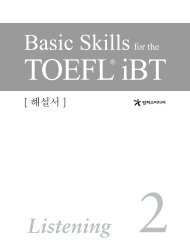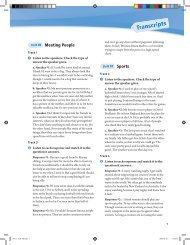Mastering Skills for the TOEFL iBT 2nd - Speaking
Mastering Skills for the TOEFL iBT 2nd - Speaking
Mastering Skills for the TOEFL iBT 2nd - Speaking
You also want an ePaper? Increase the reach of your titles
YUMPU automatically turns print PDFs into web optimized ePapers that Google loves.
Transcriptsalso allow her to pay <strong>for</strong> housing at <strong>the</strong> beginning of<strong>the</strong> semester. This way, she will not have to wait untilshe gets money from working during <strong>the</strong> school year.Q6 Practice 1Step 1 - LectureM: Today I want to talk about minimalism—a prominentmovement in American and European art—whichemerged around <strong>the</strong> 1960s. The idea of minimalismwas to reduce a work of art to its minimum numberof colors, shapes, lines, and textures. Minimalistartists resisted <strong>the</strong> traditional idea that art had torepresent an object or an experience. Instead, <strong>the</strong>ycreated paintings and sculptures that were uniqueobjects unto <strong>the</strong>mselves—objects that didn’tstand <strong>for</strong> something else. To achieve this effect,minimalist artists used two design techniques in<strong>the</strong>ir art.First, <strong>the</strong>y tended to use materials that wereuni<strong>for</strong>m in shape. Take, <strong>for</strong> instance, Carl Andre’s1969 sculpture “Steel Zinc Plain.” This is a perfectexample of how minimalist artists chose <strong>the</strong>simplest, most uni<strong>for</strong>m shapes to piece toge<strong>the</strong>ra work of art. Andre uses one of <strong>the</strong> very simplestof geometric structures: <strong>the</strong> square. He tooksquare plates of zinc and square plates of steeland arranged <strong>the</strong>m in a checkerboard pattern on<strong>the</strong> floor. So basically, he created what looked agiant checkerboard that could be walked over andstood upon.Second, minimalist artists often used one kind ofmaterial in a repeating pattern. The 1966 pieceby Dan Flavin called “Monument <strong>for</strong> V. Tatlin”clearly demonstrates <strong>the</strong> use of repetition. In thispiece, Flavin uses only one type of material: apre-made fluorescent tube—you know, those long,glowing tubes used <strong>for</strong> industrial lighting. He tookseveral of <strong>the</strong>se and arranged <strong>the</strong>m into a miniaturemonument. The idea was inspired by <strong>the</strong> Russianartist Vladimir Tatlin’s proposed design <strong>for</strong> anew revolving spiral monument that would betaller than <strong>the</strong> Eiffel Tower. But in <strong>the</strong> end, Flavincreated a simple sculpture that was nothing like<strong>the</strong> traditional grandeur of a real monument.Step 3 - Sample ResponseMinimalist artists reduced artwork to its basic colorsand shapes. The professor says minimalist artists createdsimple, unique objects by using uni<strong>for</strong>m materials andarranging lots of <strong>the</strong>m in a repeating pattern. The firstpiece that <strong>the</strong> professor mentioned was as an exampleof how minimalists use uni<strong>for</strong>m shapes. In his piece,<strong>the</strong> artist used square-shaped plates and arranged<strong>the</strong>m in a checkerboard pattern that people can walkon. The second piece <strong>the</strong> professor mentioned was anexample of how minimalists use repetition. For hispiece, <strong>the</strong> artist took several fluorescent tubes andarranged <strong>the</strong>m into a simple miniature tower. Thisminiature tower was inspired by plans <strong>for</strong> a grand newmonument.Q6 Practice 2Step 1 - LectureM: There are many <strong>the</strong>ories out <strong>the</strong>re about what ittakes to be an effective leader, but <strong>the</strong> one attributethat links all <strong>the</strong>se <strong>the</strong>ories toge<strong>the</strong>r is charisma.Charisma is <strong>the</strong> ability to inspire enthusiasm,interest, or affection in o<strong>the</strong>r people. So basically,<strong>the</strong> <strong>the</strong>ory of charismatic leadership assumesthat all good leaders must have charisma in orderto attract followers . . . and according to <strong>the</strong> <strong>the</strong>ory,charismatic leaders share two common traits.First of all, charismatic leaders create a compellingvision that appeals to <strong>the</strong>ir followers’ values,interests, hopes, and dreams. A charismatic leaderis not content simply to lead a group along itspresent course, but strives to reach high goalsand ideals. In this sense, Dr. Martin Lu<strong>the</strong>r KingJr., a famous American during <strong>the</strong> 1960s, was acharismatic leader; his vision was this: that allmen were created equal no matter <strong>the</strong>ir differences.He helped convince people that treating certainAmericans unfairly was wrong and attracted alarge number of followers who helped accomplishhis vision. He was thus able to inspire <strong>the</strong> Americangovernment to pass laws that guaranteed certainrights <strong>for</strong> all people.Secondly, charismatic leaders demonstrate <strong>the</strong>irvision through action. They don’t just delegatetasks and tell people how to behave, but ra<strong>the</strong>rexhibit ideal behavior through <strong>the</strong>ir own actions.There was a famous World War II general, namedPatton, <strong>for</strong> example, who once demonstrated thisapproach to leadership by intervening at <strong>the</strong> sceneof a traffic jam. He pulled up to <strong>the</strong> jam, and ra<strong>the</strong>rthan yelling orders, he got out of his jeep andstarted directing traffic himself. As traffic startedto move, he turned <strong>the</strong> job over to <strong>the</strong> militaryTranscripts 7
















